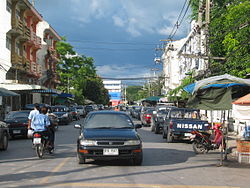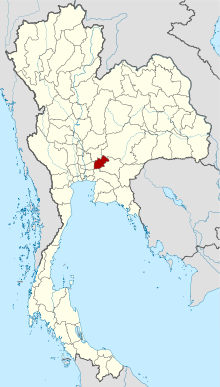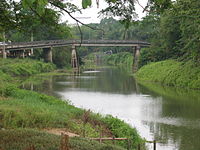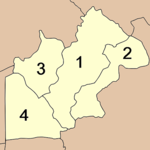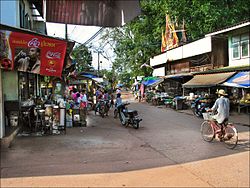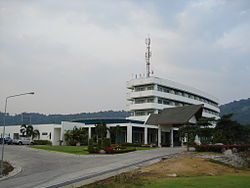- Nakhon Nayok Province
-
Nakhon Nayok
นครนายก— Province — 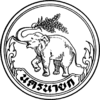
SealMap of Thailand highlighting Nakhon Nayok Province Country  Thailand
ThailandCapital Nakhon Nayok town Government - Governor Pricha Kamonlabut (since March 2009) Area - Total 2,122.0 km2 (819.3 sq mi) Area rank Ranked 66th Population (2000) - Total 241,081 - Rank Ranked 70th - Density 113.6/km2 (294.2/sq mi) - Density rank Ranked 41st Time zone Thailand Standard Time (UTC+7) ISO 3166 code TH-26 Nakhon Nayok (Thai: นครนายก) is one of the central provinces (changwat) of Thailand. Neighboring provinces are (from north clockwise) Saraburi, Nakhon Ratchasima, Prachinburi, Chachoengsao and Pathum Thani.
Nakhon Nayok is renowned for its refreshing waterfalls and abundant varieties of fruits.
Contents
Etymology
The word Nakhon originates from the Sanskrit word Nagara (Devanagari: नगर) meaning city, and the word Nayok is sometimes described to be derive from Sanskrit Nāyaka (Devanagari: नायक) meaning leader or captain. However in this connection, na means "[tax of] rice field" and yok means "exempted". Hence the name of the province literally means City of Tax-Free.[1]
Geography
Canal in Nakhon Nayok
The northern part of the province is located in the Sankambeng Range, the southern prolongation of the Dong Phaya Yen mountain range, with the highest elevation the 1292 meter high Yod Khao Kiew. Most of that area is covered by the Khao Yai National Park. The central part of the province however is a rather flat river plain formed by the Nakhon Nayok River. The southern part of the province has relatively unfertile acidic soil.
The main river of the province is the Nakhon Nayok River. It joins the Prachinburi River at Pak Nam Yothaka in Amphoe Ban Sang, Prachinburi province, which then becomes the Bang Pa Kong River.
Wang Takhrai is a botanical garden belonging to the Chumphot - Phanthip Foundation. Located at the Wang Takhrai waterfall it is a popular place for tourists to visit. Several other waterfalls within the province are well-known as touristical targets - Nangrong and the nine-leveled Sarika waterfall are located within the Khao Yai NP, and also the Lan Rak (or Tat Hin Kong) waterfall.
History
The city of Nakhon Nayok dates back to the Dvaravati kingdom, probably founded in the 11th century. Ruins from this time are visible at Mueang Boran Dong Lakhon south of the modern city. Originally named Mueang Lablae, the name Nakhon Nayok was assigned to it in 1350, when it became a garrison town of the Ayutthaya kingdom protecting the eastern boundary.
January 1, 1943 the government downgraded Nakhon Nayok Province and combined it with Prachinburi Province, except Ban Na district which became part of Saraburi Province.[2] On May 9, 1946 the province was re-established.[3]
Symbols
The provincial seal shows an elephant holding an ear of rice with its trunk. This symbolizes the fertile rice fields as well as the forests with numerous elephants. In the background two piles of straw, trees and clouds symbolize the natural beauty of the province.
Provincial flower and tree is the Silk-Cotton Tree (Cochlospermum religiosum).
Administrative divisions
The province is subdivided into 4 districts (Amphoe). The districts are further subdivided into 41 subdistricts (tambon) and 403 villages (muban).
Tourism
Sights
San Lak Mueang (City Pillar Shrine) (ศาลหลักเมือง) at one time it was a shrine housing a 1-metre wooden column topped with a carving in the form of a lotus bud, situated near the Old City Wall. Later the shrine was rebuilt into an elegant four-cornered pavilion. Nowadays, City Pillar Shrine is the most revered shrine of the townspeople.
Chulachomklao Royal Military Academy (โรงเรียนนายร้อยพระจุลจอมเกล้า) It is a training centre for the Thai military cadet. There are several interesting attractions in the Academy compound, which can be accessed by car. Attractions in the Chulachomkloa Royal Military Academy include:
King Rama V Monument (พระบรมราชานุเสาวรีย์พระบาทสมเด็จพระจุลจอมเกล้าเจ้าอยู่หัว) It was built in honour of and reverence to His Majesty King Chulalongkorn (King Rama V) who was the founder of the Chulachomklao Royal Military Academy.
Circular Pavilion (ศาลาวงกลม), historically, under the command of Field Marshal Crown Prince Pitsanulok Prachanat, the circular pavilion was built as a recreation area for the military cadet. It enshrines a sculpture of King Rama V.
100 Year Royal Military Academy Museum (อาคารพิพิธภัณฑ์โรงเรียนนายร้อย จปร. 100 ปี) exhibits biographies of the graduates who performed public services and also displays history of wars, weapons that were used in wars in the past, various uniforms of soldiers of all forces as well as a wax sculpture of King Rama V.
Shrine of Chao Pho Khun Dan (ศาลเจ้าพ่อขุนด่าน) is a revered shrine of the Thais. Historically, Khun Dan was a commander in Nakhon Nayok during the Ayutthaya period. His heroic deed was the expulsion of the Khmer rebels in the year 1587, during the reign of King Naresuan Maharat.
Phra Phutthachai or Wat Phra Chai (พระพุทธฉายหรือวัดพระฉาย) was formerly named “Wat Khao Cha-ngok”. In the year of 1942, the Army’s Map Department built a marble quarry at the foot of the hill and restored and enhanced the Buddha images. Phra Phutthachai is sacred to the townspeople.
Luang Pho Sian Nakhon (หลวงพ่อเศียรนคร) the revered Buddha image of the townspeople is enshrined at Bunnak Rakkitaram temple (Wat Tam). It is assumed that this sacred Buddha image dates back to Phra Ruang Era of the Sukhothai period.
Lord Buddha’s Footprint Replica at Khao Nang Buat (รอยพระพุทธบาทจำลองเขานางบวช), housed in a square structure with four arches and a pyramidal roof (mondop) on top of Nang Buat hill. The festivity to worship the Lord Buddha’s Footprint Replica at Khao Nang Buat is held annually in the middle of the fifth month of the lunar calendar.
Ban Dong Lakhon Archeological Site (แหล่งโบราณคดีบ้านดงละคร) It is the site of the location of the old town during the Khmer period. Artefacts discovered in this are include; an elaborate gold head of a Buddha image about the size of a fingertip, crab and elephant ring-stamps, bronze ring, glass beads, rock beads, and bronze ear-rings.37th Quartermaster Infantry of Japanese Military Memorial (อนุสรณ์สถานกองพลทหารญี่ปุ่นที่37) The Friend of Asian Alliance War Association built the memorial in 1992 to honour the 7,920 Thai soldiers who were recruited into the Japanese 37th Quartermaster Infantry that died in the war.
Namtok Sarika (น้ำตกสาริกา) is the most famous waterfall of Nakhon Nayok. The waterfall cascades down in 9 levels, of which the top level is 200 metres up. Each level (of 9 levels) of the falls has a large basin, which could hold a large amount of water in the rainy season, but it is dried up in dry season. Nearby, there is “Sarika Cave” where the revered monk “Luang Pu Man” resided on his religious missions from 1917-1920.
Lan Rak Falls or Tat Hin Kong Falls (น้ำตกลานรักหรือน้ำตกตาดหินกอง) The attractive waterfall originates from a small stream passing through a large rocky formation at the end, then flowing strongly through the large rocky formation at the foot of a small hill.
Wang Takhrai (วังตะไคร้) is filled with huge, shady trees and has a small stream running through. There are also a variety of beautiful species of ornamental flowers and plants.
Nang Rong Falls or Namtok Nang Rong (น้ำตกนางรอง) The waterfall originates from a source on a high mountain in Khao Yai National Park. It cascades down several levels onto rock formations, flowing through verdant forests
Huai Prue Reservoir (อ่างเก็บน้ำห้วยปรือ) This is a small reservoir by volume but has a large water surface. The reservoir is filled all year round and surrounded by an unpaved road.
Sai Thong Reservoir (อ่างเก็บน้ำทรายทอง) This small reservoir offers a natural mountainous landscape. The small waterfall runs all throughout the year. OUT-OF CITY ATTRACTIONS Amphoe Ban Na
Namtok Ka-ang (น้ำตกกะอาง) The water cascades through gaps between large rocks. Nearby, there is an Agriculture Transplanting station of the Forestry Department. In the vicinity is a small hill that enshrines the Buddha image in an attitude of subduing Mara.
Namtok Wang Muang (น้ำตกวังม่วง) The waterfall features cascades through lines upon lines of big boulders and falling to a basin.
Thudongkhasathan Thawon Nimit (ธุดงคสถานถาวรนิมิตร) is a meditation centre of monks, novices, nuns, and the general public. There are hundreds of shelters for monks, nuns, and general public to practice the Buddhist perceptions.
Namtok Heo Narok (น้ำตกเหวนรก) This is a 3-tiered large waterfall with its first tier at 60 metres high. During the rainy season, there is such a lot of water that the flow is frightening and will drop straight down at 90 degrees to a lower chasm.Chao Pho Ongkharak Shrine (ศาลเจ้าพ่อองครักษ์) In front of the shrine in the middle of the Nakhon Nayok river, there is a sacred whirlpool, of which the water taken is used in royal ceremonies. When the present king, King Bhumibol Adulyadej ascended to the throne, water from this whirlpool was used during the ceremony.
Ornamental Plants and Floral Centre (ศูนย์ไม้ดอกไม้ประดับ) On this road, especially at the intersection of khlong 15, there are various plant nurseries that grow a large variety of ornamental plants and flora which are sold to every corner of the country.Activities
Canoeing in Nakhon Nayok River (ล่องแคนูในลำน้ำนครนายก) is fast becoming a popular sport that has made Nakhon Nayok famous. The best time of year for canoeing is during the months of June to October
Mountain Bikes (จักรยานเสือภูเขา) is another activity as popular as canoeing. This activity can be taken up all year round.
Khao Yai-Nakhon Nayok Jungle Treks (ท่องไพรเขาใหญ่-นครนายก) is usually held during December to June. The trekking aims to promote the study of nature and ecology, as well as creating good understanding in natural resources and environmental conservation.Khao Yai National Park, the first national park of Thailand was declared a national park on September 18, 1962. It covers areas of four provinces: Nakhon Nayok, Nakhon Ratchasima, Prachin Buri, and Saraburi. The park occupies an area of 2,168 square kilometers and consists of virgin forest, tropical forest, streams, waterfalls, wildlife, and a variety of plants. The most suitable visiting time is during the Thai winter, from October to February when it is cold at night until the next morning. The highest point is Khao Rom Peak, which is 1,351 metres above sea level.
Local Products
Sweet Plum Mango (Ma-prang, มะปราง) is the most well known fruit of Nakhon Nayok (it is a sweet fruit and is similar to “Ma-yong-chit” - a fruit of sour taste). The harvesting season of Ma-prang is during February to March. They are grown in a number of orchards located on Nakhon Nayok-Namtok Sarika route
Dala (ดอกดาหลา) is a flower of Etlingera or Jack Jr. Rosemary. Along Highway Number 3049 as well as the route to Wang Ri Resort, a number of Dala orchards can be found. For your own try at flower cutting and a direct purchase of flowers from the orchards is possible at Suan Dala Saeng Thong. The Dala’s blooming season is from November to May.
Marble Products (ผลิตภัณฑ์หินอ่อน): A marble quarry is located near Nakhon Nayok hospital, Amphoe Mueang, and at the intersection to Chulachomklao Royal Military Academy.
Bamboo Products (ผลิตภัณฑ์จากไม้ไผ่) Bamboo products are produced in Tambon Sarika, Amphoe Mueang. Products include a miniature sail boat, a peacock, and human faces.
Brooms (ไม้กวาด) Manufactured in Tambon Sarika, Amphoe Mueang, Tambon Na Hin Lat, Tambon Khok Kruat, Tambon Nong Saeng, Amphoe Pak Phli. The brooms are made with indigenous grass and the broomstick is made from a piece of wood from a tree of the Apocynaceae family or made of bamboo. It can be found throughout the province.
Doormats made from scrap cloth (พรมทอจากเศษผ้า) are produced in Tambon Khao Phoem, Amphoe Ban Na. The scrap cloth, also made into bed covers, are sold in various sizes at furniture stalls of Ban Na market and Amphoe Mueang.
Khanom Pia (ขนมเปี๊ยะ) is made at Amphoe Ban Na. It was so good that it received the “Shell Chuan Chim” mark, a guarantee of a good taste
Sugared Banana Chips (Kluai Chap) (กล้วยฉาบ) and sugared sweet potato and sugared taro chips are produced in Tambon Sarika, Amphoe Mueang.
Preserved Fruits (ผลไม้แช่อิ่ม) such as star apples, tamarinds, mangos, santol, and lime. They are sold at the Ban Yai intersection, Amphoe Mueang or Dong Chok Di Housewife Association at Ban Dong, Tambon Sarika, Amphoe Mueang. The supply of fruits comes from fruit orchards of the members; some of the cultivated fruits are sold fresh while others are converted into various products.Culture
Festivals
Tak Bat Thewo Rohana Fair (งานประเพณีตักบาตรเทโวโรหนะ), a festivity where offerings are made to monks. The festivity is held annually on the 1st day of the waning moon of the 11th month of the lunar calendar or the end of the Buddhist lent. During the festivity, 109 monks descend from Wat Khao Nang Buat to accept offerings from the townspeople.
Sweet Plum Mango and Nakhon Nayok Products Fair (งานวันมะปรางหวานและของดีนครนายก) takes place annually during February–April in front of the City Hall. It is held to promote Ma-prang (sweet plum mangoes), and other agricultural products and handicrafts
Thai Merit Making (Sat Thai) & Long boat Racing Festival (งานประเพณีสารทไทยและแข่งเรือยาวประเพณี) is annually held in October along Khlong 29 at Wat Thawiphon Rangsan, Amphoe Ongkharak. The fair showcases a variety of long boats racing, making Krayasat contest (Krayasat is a sticky paste made from rice, bean, sesame, and sugar, usually eaten during Sat Thai Festival), merit making on Sat Thai day, and local entertainment at night.
Ongkharak Ornamental Plants and Flowers Fair (งานมหกรรมไม้ดอกไม้ประดับองครักษ์) is annually held in April at Khlong 15, Tambon Bang Pla Kot, Amphoe Ongkharak. The contests of ornamental plants and flowers, mini-garden arrangement contests, and an academic exhibition regarding plants and flowers are also held.References
- ^ "ประวัติจังหวัดนครนายก" (in Thai). จังหวัดนครนายก. http://www.nakhonnayok.go.th/cms/modules/sections/index.php?op=viewarticle&artid=2. Retrieved 2008-03-07.
- ^ "พระราชบัญญัติยุบและรวมการปกครองบางจังหวัด พุทธศักราช ๒๔๘๕" (in Thai) (PDF). Royal Gazette 59 (77 ก): 2447–2449. December 10, 1942. http://www.ratchakitcha.soc.go.th/DATA/PDF/2485/A/077/2447.PDF.
- ^ "พระราชบัญญัติจัดตั้งจังหวัดสมุทรปราการ จังหวัดนนทบุรี จังหวัดสมุทรสาคร และจังหวัดนครนายก พุทธศักราช ๒๔๘๙" (in Thai) (PDF). Royal Gazette 63 (29 ก): 315–317. May 9, 1946. http://www.ratchakitcha.soc.go.th/DATA/PDF/2489/A/029/315.PDF.
External links
- News and Information in Nakhonnayok (thai)
- Province page from the Tourist Authority of Thailand
- Website of province (Thai)
- Nakhon Nayok provincial map, coat of arms and postal stamp

Saraburi Province Nakhon Ratchasima Province 
Pathum Thani Province 
Prachinburi Province  Nakhon Nayok Province
Nakhon Nayok Province 

Chachoengsao Province Coordinates: 14°12′44″N 101°12′06″E / 14.21222°N 101.20167°E
Provinces of Thailand Capital: Bangkok North North-East Amnat Charoen · Bueng Kan · Buri Ram · Chaiyaphum · Kalasin · Khon Kaen · Loei · Maha Sarakham · Mukdahan · Nakhon Phanom · Nakhon Ratchasima · Nong Bua Lamphu · Nong Khai · Roi Et · Sakon Nakhon · Sisaket · Surin · Ubon Ratchathani · Udon Thani · YasothonCentral Ang Thong · Chai Nat · Kamphaeng Phet · Lop Buri · Nakhon Nayok · Nakhon Pathom · Nakhon Sawan · Nonthaburi · Pathum Thani · Phetchabun · Phichit · Phitsanulok · Phra Nakhon Si Ayutthaya · Samut Prakan · Samut Sakhon · Samut Songkhram · Saraburi · Sing Buri · Sukhothai · Suphan Buri · Uthai ThaniEast West South Chumphon · Krabi · Nakhon Si Thammarat · Narathiwat · Pattani · Phang Nga · Phatthalung · Phuket · Ranong · Satun · Songkhla · Surat Thani · Trang · YalaCategories:
Wikimedia Foundation. 2010.

